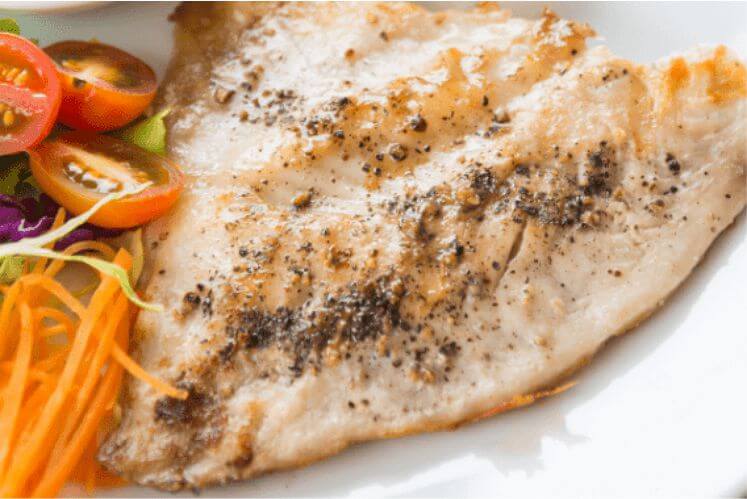Simple and easy-to-follow Frozen Fish Fillets in Air Fryer [Unbreaded] recipe to make a healthy meal today.
Quick Page Guide
Fish Introduction
Fish are aquatic, gill-bearing, craniate animals lacking limbs with digits that are gill-bearing and lack limbs. This definition includes living hagfishes, lampreys, cartilaginous and bony species as well as extinct related species.
About 99% of the living fish species are ray-finned, and over 95% are teleosts, the subgroup of the Actinopterygii in the class Actinopterygii. Despite the term fish describing a life-form rather than a taxonomic group, it encompasses a variety of vertebrates that come from several evolutionary lines.
Chordata members share certain traits with vertebrates, including gills that open in some stage of their lives, skeletal struts called notochords, and hollow nerve ropes attached to the dorsal side of the body.

The five classes of living fishes are as distinct from one another as the familiar four classes of air-breathing mammals, birds, and reptiles. As laboratory animals, fish are often used in medical and biological research. The animals that primarily live in water are referred to as fish in this article.
Specifically, fishes are classified by their scales or fins, cartilaginous tissue (sharks and rays), amphibians, reptiles (water snakes, turtles, tortoises), and most importantly, marine mammals (seals, whales, dugongs, and manatees) that provide food, fuel, and cover for marine life.
Mollusks (such as mollusk meat, shells, pearls, and dyes such as Tyrian purple) and crustaceans, such as shrimp, crabs, and lobster, are also among fishes. Echinoderms, such as sea urchins and trepang, are included as well.
Fish Origin
It was during the Cambrian explosion that fish evolved 530 million years ago. Early chordates developed a skull and vertebral column, giving rise to the first creatures and vertebrates.
An example of an early jawless fish is Haikouichthys, which comes from the Agnathes lineage. Ostracoderms, which are mostly armored fish, and jawless fish called conodonts made their first appearances in the late Cambrian.
This group might have evolved early from other agnathans since lampreys belong to the Cyclostomata, which also includes hagfish.
From the Silurian era, the earliest jawed vertebrates are known to be two groups of fish: Acanthodii (or spiny sharks), which are armored marine fish that evolve from ostracoderms; and placoderms.
There was a high level of variety among fish species during the Devonian period, especially among placoderms, as well as among lobe-finned fish and early sharks. In addition to amphibians, reptiles, mammals, and birds, tetrapods evolved from lobe-finned fish.
Fish evolved into tetrapods, which include amphibians, reptiles, mammals, and birds, during the Devonian. During the Devonian period, creatures like mice and rats first appeared with their transitional limbs.
10 Types of Fishes
There is a variety listed here that is of culinary interest either marketed in Southern California or widely available at the fish markets. The primary name is recorded here when it corresponds to names in the fish markets, and Fishbase when it doesn’t (often). Here, we enlisted some varieties of fish one by one below.
 Anchovy Fish
Anchovy Fish
Various species of tiny fish live in temperate seas worldwide in large schools. They are incredibly important to the fish food chain as well as the production of fermented fish sauce, an ingredient integral to Southeast Asian cuisines as it was to the Empire.
The Anchovy Family now possesses the technology to manufacture this consumable.
Barracuda Fish
A 42-1/2 inch Pacific Barracuda (Sphyraena argentea), which weighs 8-1/3 pounds and has strong jaws and sharp teeth. These fish are fearsome predators found mostly in tropical and sub-tropical seas.
There are several species of this fish, but only one is common north of Point Conception in Southern California. The small one grows to a length of nearly 60 inches and a weight of around 26 pounds, while the large one grows to a length of 72 inches and 100 pounds.
Bass Fish
Many fish called “bass” are sunfish rather than basses, such as largemouth and smallmouth Sunfish. Below are pictures of the real fish (even though one of them is referred to as “perch”), as well as links to additional information.
Belt Fish
The Belt fish is measured as 34-1/2 inches long and weighed 1 pound 3/4 ounce. It is a highly commercial fish, mainly for Asia, and is found in tropical and temperate waters worldwide. It can grow to over 7-1/2 feet long and 11 pounds. Additionally, Beltfish can be found in Brazil, Portugal, Italy, and Pakistan and does not care at all about being kosher.
Shark Fish
Under severe stress, some of these older fish redeveloped features of their primitive ancestors with some additions. The result is that sharks are truly different from other fish. Sharks are much more intelligent than modern fish and can form complex social structures.
They give live birth instead of laying eggs. Sharks are much larger brains than modern fish. The cartilage in their skeleton allows them to float and grow very large even though they lack bones.
Their lightweight skeleton also allows them to avoid having a swim bladder, so they can sink or rise very quickly in a pool.
Sole Fish
The term “Sole” without any qualifier means the Common Sole, a fish also known as “Dover Sole”, which is a product of the Dover region of England. There is a second fish of the same name, which has created confusion and subterfuge.
There are many of these fish in the British Isles, the German north coast, and the coast of France. Native to the coastal waters of the North Atlantic from Norway to the northwest coast of Africa, they are most numerous on the coast of the British Isles.
The Black Sea and the Mediterranean Sea are home to less abundance of this species. The fish can grow to 27 inches long and 6.6 pounds in weight, but it’s more common to see it grow around 12 inches in length.
Trout Fish
The term trout refers not to the species of fish that are technically trout, but to fish that are related to the species.
Among Oncorhynchus are Pacific Salmon, Apache trout (Arizona), Cutthroat trout (western North America), Gila trout (Arizona, New Mexico), Rainbow trout / Steelhead (western United States).
Salmo populations include Atlantic Salmon Adriatic trouts, Brown trouts (Europe and Asia), Marble trouts (southeastern Europe), Ohrid trouts (Macedonia, Albania), Sevan trouts (Armenia native), and Kyrgyzstan (introduced).
SilverFish
Their larvae-like characteristics remain, including a lack of color, uncalcified bones, and no scales, as they are related to trout, salmon, and smelts.
It is found in salt, brackish and freshwater along the East Asian coast from Korea to Vietnam, in Chinese rivers and lakes, and around Japan and the Philippines.
While alive, it is nearly transparent, but when it dies, it turns milky white, making it a valuable resource for the fishing industry.
Mullet Fish
Saltwater fish in the “mullet” family is fairly large. Although they have always been relatively popular in the Mediterranean region and along the coasts of Europe, they were seldom used in North America until recently. Nowadays, Asian markets in Southern California are quite popular with them.
Eel Fish
The Anguilliformes consist of a large group of fish that has evolved to resemble snakes and worms. Anguilliformes are in some ways rather primitive and rather simplified compared to other modern ray-finned fish.
The freshwater eels spawn at sea and die there. Their juveniles move into rivers and live here until spawning occurs.
They are not kosher due to the lack of scales in most cases and the difficulty of removing the scales without tearing the skin.
What to Serve with Fish?
There is a fish side dish recipe for every meal, from stews to warm roasted filets! Make your next feast a truly spectacular one by pairing your fish entree with one of these tasty sides.
With some roasted vegetables on your plate, you can keep your plate lean, or add a comforting rice pilaf to make it heartier. With so many choices available, you can finally stop trying to come up with what to serve with fish.
Now, we enlisted some side dishes which you can serve with fish and get the most delicious taste.
- Rice Pilaf
- Roasted Greek Potatoes
- French fries
- Cheese Cauliflower Rice
- Tartar Sauce
- Papa Jhon’s Garlic Sauce
- Grilled Vegetable Skewers
- Panzanella Salad
- Best Green Beans
- Mashed Potatoes
- LemoDressing
FAQs
Can you cook frozen raw fish in an air fryer?
The air fryer is the perfect appliance for making a delicious dinner quickly when you have frozen fish fillets on hand! By using a few simple spices and your favorite white fish fillets, you will have a meal that is perfectly flakey and super tasty.
Can you put aluminum foil in an air fryer?
In simple terms, yes. You can use aluminum foil in an air fryer. However, it depends on the type of food you are cooking, and the model of the air fryer. Check your owner’s manual for specific instructions before using aluminum foil in your air fryer.
How to cook Frozen Fish Fillets in Air Fryer
When you can cook frozen fish in your air fryer, you can make fabulous fish for dinner in no time! With just a few spices and your favorite white fish fillets, you will have perfectly flakey and incredibly delicious fish in minutes.
How long to cook Frozen Fish in Air Fryer
Spray the air fryer basket with grapeseed oil spray and place the frozen fish fillets inside. Spray the fish an additional two or three times with the oil spray. Cook at 390*F for 10 minutes or until the fish flakes easily with a fork.

Tips for Cooking Frozen Fish Fillets in Air Fryer
Make sure you check out these tips and substitutions for air fryer frozen fish fillets before beginning the recipe.
- This recipe can be made with any white fish you have or prefer. We prefer wild pollock, but you can also use frozen cod or tilapia.
- If the fish fillets are thin, they’ll cook faster and you don’t need to flip them halfway through. If they’re thicker, they’ll take longer to cook and you’ll have to flip them halfway through.
- We often cut fish fillets in half if they are too long to fit into our air fryer.
- Because our fish fillets were a little smaller overall, you may need to add a bit more spice blend to cover larger fillets with lots of surface area.
- you can use dried parsley, Italian seasoning, or other herbs if you do not have fine herbs seasoning.
- You should cook the fish to 145 degrees Fahrenheit for flaky, succulent fish – but don’t overcook since this can make the fish rubbery.
Step by step Recipe for Frozen Fish Fillets
Follow this section for instructions on how to air fry frozen fish.
![Frozen Fish Fillets in Air Fryer [Unbreaded]](https://samarascuisine.com/wp-content/uploads/2022/03/Frozen-Fish-Fillets-in-Air-Fryer-Unbreaded.jpg)
Step 1
Place the frozen fish on a large plate after rinsing them under cold running water. Preheat the air fryer to 350 degrees Fahrenheit.
Step 2.
Prepare the seasonings in a small bowl while the air fryer is heating.
Step 3
Once the oil is placed on the fish, you can spray it lightly or rub it in (on both sides). Finally, you can sprinkle the spice mixture onto the fish, or only on the flesh side if it has skin. You should also drizzle lemon juice on each fillet.
Step 4
Frozen fish fillets should be added directly to the air fryer tray when it’s hot. The fillets should not overlap.
Step 5
Fillets should be cooked for 12 to 17 minutes, depending on how thick they are.
Step 6
If you have a fork, you can test the fillet for readiness. Otherwise, 145 degrees Fahrenheit should be the internal temperature.
Step 7
The flipping process is not necessary for thin fish fillets. For thicker fillets, it is important to flip the fish after around eight minutes of cooking so that the fish is not overcooked. Using these times as guidelines is a good idea because the cooking time will depend on the fillet thickness and your air fryer.
Step 8
Serve the fish fillets with lemon wedges after the fish has been cooked in the air fryer.


 Anchovy Fish
Anchovy Fish